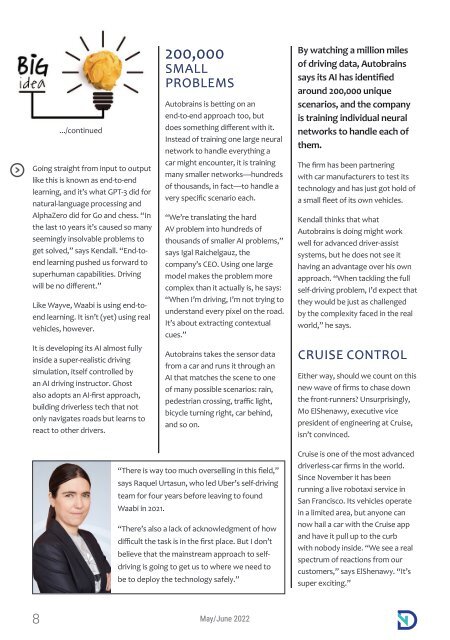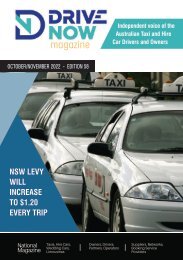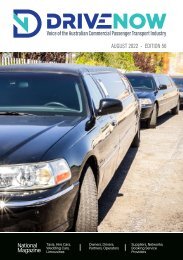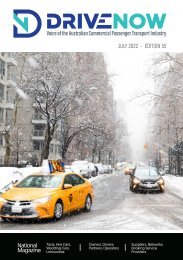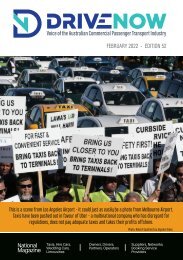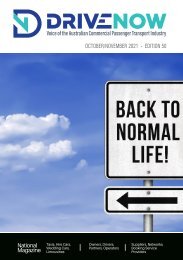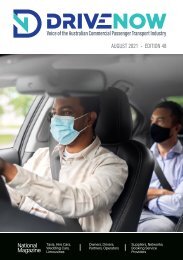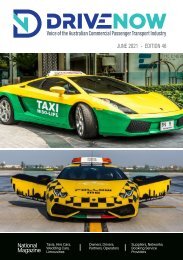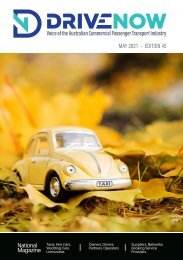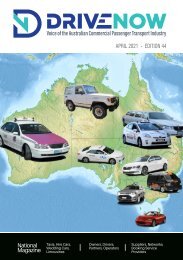DRIVE NOW May/June 2022
*** SCROLL DOWN TO SELECT ALTERNATIVE MAGAZINE EDITIONS *** Australia's only Magazine for the Commercial Passenger Transport Industry. News and views for Drivers, Owners and Operators of Taxi, Hire Car, Limousine, Ride Share, Booked Hire Vehicles, Rank and Hail Cars.
*** SCROLL DOWN TO SELECT ALTERNATIVE MAGAZINE EDITIONS ***
Australia's only Magazine for the Commercial Passenger Transport Industry. News and views for Drivers, Owners and Operators of Taxi, Hire Car, Limousine, Ride Share, Booked Hire Vehicles, Rank and Hail Cars.
You also want an ePaper? Increase the reach of your titles
YUMPU automatically turns print PDFs into web optimized ePapers that Google loves.
.../continued<br />
Going straight from input to output<br />
like this is known as end-to-end<br />
learning, and it’s what GPT-3 did for<br />
natural-language processing and<br />
AlphaZero did for Go and chess. “In<br />
the last 10 years it’s caused so many<br />
seemingly insolvable problems to<br />
get solved,” says Kendall. “End-toend<br />
learning pushed us forward to<br />
superhuman capabilities. Driving<br />
will be no different.”<br />
Like Wayve, Waabi is using end-toend<br />
learning. It isn’t (yet) using real<br />
vehicles, however.<br />
It is developing its AI almost fully<br />
inside a super-realistic driving<br />
simulation, itself controlled by<br />
an AI driving instructor. Ghost<br />
also adopts an AI-first approach,<br />
building driverless tech that not<br />
only navigates roads but learns to<br />
react to other drivers.<br />
200,000<br />
SMALL<br />
PROBLEMS<br />
Autobrains is betting on an<br />
end-to-end approach too, but<br />
does something different with it.<br />
Instead of training one large neural<br />
network to handle everything a<br />
car might encounter, it is training<br />
many smaller networks—hundreds<br />
of thousands, in fact—to handle a<br />
very specific scenario each.<br />
“We’re translating the hard<br />
AV problem into hundreds of<br />
thousands of smaller AI problems,”<br />
says Igal Raichelgauz, the<br />
company’s CEO. Using one large<br />
model makes the problem more<br />
complex than it actually is, he says:<br />
“When I’m driving, I’m not trying to<br />
understand every pixel on the road.<br />
It’s about extracting contextual<br />
cues.”<br />
Autobrains takes the sensor data<br />
from a car and runs it through an<br />
AI that matches the scene to one<br />
of many possible scenarios: rain,<br />
pedestrian crossing, traffic light,<br />
bicycle turning right, car behind,<br />
and so on.<br />
By watching a million miles<br />
of driving data, Autobrains<br />
says its AI has identified<br />
around 200,000 unique<br />
scenarios, and the company<br />
is training individual neural<br />
networks to handle each of<br />
them.<br />
The firm has been partnering<br />
with car manufacturers to test its<br />
technology and has just got hold of<br />
a small fleet of its own vehicles.<br />
Kendall thinks that what<br />
Autobrains is doing might work<br />
well for advanced driver-assist<br />
systems, but he does not see it<br />
having an advantage over his own<br />
approach. “When tackling the full<br />
self-driving problem, I’d expect that<br />
they would be just as challenged<br />
by the complexity faced in the real<br />
world,” he says.<br />
CRUISE CONTROL<br />
Either way, should we count on this<br />
new wave of firms to chase down<br />
the front-runners? Unsurprisingly,<br />
Mo ElShenawy, executive vice<br />
president of engineering at Cruise,<br />
isn’t convinced.<br />
“There is way too much overselling in this field,”<br />
says Raquel Urtasun, who led Uber’s self-driving<br />
team for four years before leaving to found<br />
Waabi in 2021.<br />
“There’s also a lack of acknowledgment of how<br />
difficult the task is in the first place. But I don’t<br />
believe that the mainstream approach to selfdriving<br />
is going to get us to where we need to<br />
be to deploy the technology safely.”<br />
Cruise is one of the most advanced<br />
driverless-car firms in the world.<br />
Since November it has been<br />
running a live robotaxi service in<br />
San Francisco. Its vehicles operate<br />
in a limited area, but anyone can<br />
now hail a car with the Cruise app<br />
and have it pull up to the curb<br />
with nobody inside. “We see a real<br />
spectrum of reactions from our<br />
customers,” says ElShenawy. “It’s<br />
super exciting.”<br />
8 <strong>May</strong>/<strong>June</strong> <strong>2022</strong>


